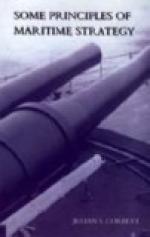OFFENSIVE OPERATIONS USED WITH A DEFENSIVE INTENTION
(A) Counter attacks.
(B) Diversions.
(A) Counter attacks are those which are made upon an enemy who exposes himself anywhere in the theatre of his offensive operations. It is this form of attack which constitutes what Clausewitz calls the “surprise advantage of defence.”
(B) Diversions are similar operations undertaken against an enemy outside the limit of his theatre of offensive operations.
Diversions are designed to confuse his strategy, to distract his attention, and to draw off his forces from his main attack. If well planned, they should divert a force greater than their own. They should, therefore, be small. The nearer they approach the importance of a real attack the less likely they are to divert a force greater than their own.
It is only their power of diverting or containing a larger force than their own that justifies the breach of the law of concentration which they involve.
This power depends mainly on suddenness and mobility, and these qualities are most highly developed in combined expeditions.
NOTE.—Diversions must be carefully distinguished from eccentric attacks. Eccentric attacks are true offensive movements. They have a positive object, i.e., they aim to acquire something from the enemy; whereas diversions have a negative object, i.e., they aim at preventing the enemy doing or acquiring something. Being in the category of the weaker form of war, eccentric attacks are usually made in greater force than diversions.
EXAMPLES.—Diversion.—Our raid on Washington in 1815. Landing force, about 4,000 men. Object, according to official instructions, “a diversion on the coasts of United States of America in favour of the army employed in the defence of Canada”; i.e., the intention was negative—preventative—defensive.
2. Eccentric Attack.—Operations against New Orleans in 1815. Intended force 15,000 to 20,000 men. Object, “to obtain command of embouchure of the Mississippi, and, secondly, to occupy some important and valuable possession, by the restoration of which the conditions of peace might be improved, &c.”; i.e., the intention was positive—to acquire. Compare Rochefort Expedition (diversion) and Belleisle (eccentric attack) in the Seven Years War.
Note 2.—This distinction
gives a threefold classification of combined
expeditions, as used by Elizabethan
strategists.
Raids
= Diversions.
Incursions
= Eccentric attacks.
Invasions
= True direct offence.
Compare these with Sir John
Ardagh’s classification (Report of Royal
Commission on Reserve Forces,
1904):—
“Raids,”
not exceeding 10,000 men.
“Small expeditions,”
not exceeding 50,000 men.
“Dangerous
invasion,” not exceeding 150,000 men.




